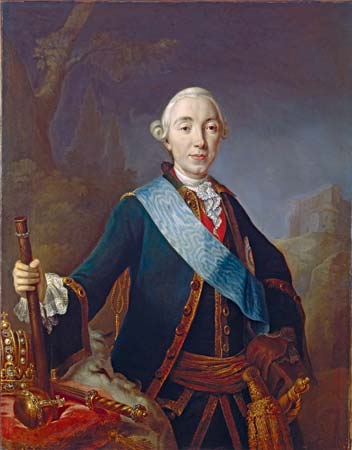
PHOTO: Britannica
Last week on History’s Nutcases, we met Charles VI. This week, we have yet another insane monarch for you, a monarch named Peter III. He was Czar of Russia during the mid 18th century, and only ruled for a mere six months before he was overthrown by his wife, Catherine the Great. He was later assassinated in 1762 when he was just 34 years old. He caused quite a lot of trouble during his short reign, however, which made him a very unpopular ruler.
Early Life
Czar Peter III of Russia was born on February 21, 1728, in Kiel, Germany. He was son of Anna, one of Peter the Great’s daughters, and Charles Frederick, duke of Germany, which made him technically German. How on earth did he become Czar of Russia, then? Well, he wasn’t supposed to be originally. In fact, he was the grandson of Charles XII of Sweden, on his father’s side, which meant that once his parents died when Peter was young, he was placed into the care of tutors and officials at the German court. Their job was to groom him for the Swedish throne.
Young Peter had a very unhappy childhood. His tutor was a cruel, sadistic man, and Peter was a very poor student. He had a lot of interest in the arts, but he failed in nearly every academic subject. Consequently, he was beaten, starved, and generally mistreated during the formative years of his life. It was a treatment that would later forge him into a strange breed of manchild-psychopath.
When Peter III was just fourteen, his closest relative, his aunt Elizabeth on his mother’s side, became Empress of Russia. She whisked young Peter away from everything he knew, renamed Pyotr Fyodorovich, inducted into the Russian Orthodox faith, and proclaimed him heir to the Russian throne. The trouble was, Peter hated living in Russia, and the Russian people hated Peter.
Marriage to Catherine
On August 21, 1745, when Peter was just seventeen, he married a young, intelligent princess from Anhalt-Zerbst, in Germany, named Sophie Frederike Auguste, who took the name Yekaterina Alekseyevna, or, as we better know her in history, Catherine.
It was a terrible match. Catherine was a girl of prodigious intellect, savvy at court, and she did her best to Russianize herself, get her courtiers to warm to her and to make allies her new home. Peter, on the other hand, was an epic man-child. He spent every night in bed with her playing with the toy soldiers he was so obsessed with. Sometimes, he would force his new wife to dress up as a soldier so he could pretend to be a general and put her through intense, rigorous military drills. When he grew bored of that, he’d beat his hunting dogs.
The story goes that, one time, after he’d spent hours meticulously setting up his toy soldiers in pretty rows all throughout his bedroom, a rat came out of the woodwork and chewed the head off of one of Peter’s toys. The young Czar was so incensed that he caught the rat and held a proper military court martial for it. He proclaimed the rat guilty of treason and hung it on a tiny gallows he’d constructed just for the occasion. His wife, Catherine wrote about this event and many others in her memoirs, depicting him as an idiot, a drunkard, prone to brutal practical jokes and interested only in playing with his toy soldiers.
Now, he might have ruled for many years (insane rulers often did), except for one thing: Peter was obsessed with Germany and Prussia, and he hated Russia, and Russia hated Peter. The moment Peter III became Czar of Russia, he reversed his aunt’s foreign policy against Prussia, withdrew Russia from the war with Frederick the Great (even though Frederick was losing!), and, as if that wasn’t enough, he struck an alliance with Prussia and planned to start a war with Denmark! On top of all that, he alienated the Russian Orthodox church when he attempted to force it to adopt Lutheran religious practices, and thought it would be an excellent idea to threaten to disband his own personal guard.
Abdication and Death
In all of six months, Peter III was without friends at court and without a loyal personal guard. He’d managed to make all of Russia angry. Around the year of 1762, when he was just 34, his wife, Catherine, suspected that he meant to divorce her. Well, Catherine was intelligent and completely capable of ruling by herself, and she had many supporters at court. She was not about to lose the Russian throne. So, she conspired with her lover and other members of Peter III’s own guard to overthrow him.
On July 9, 1762, Catherine, with the approval of the Russian guard, the Russian Orthodox Church, and the entire senate, became Catherine II, Empress of Russia. She forced Peter to formally abdicate, and he was arrested and taken into custody. Just nine days later, on July 18th, 1762, he was assassinated, probably at Catherine’s own command.

